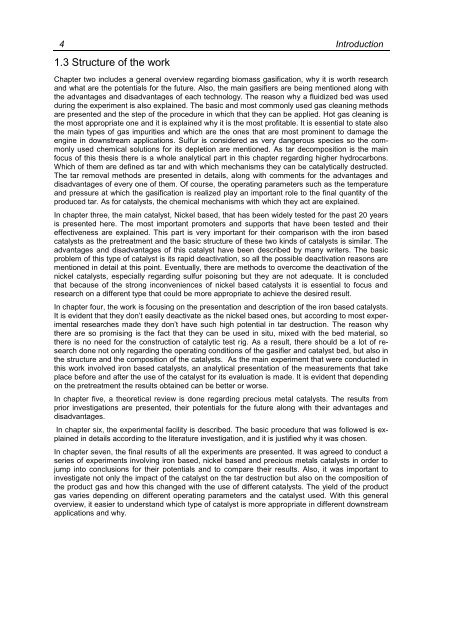Dipl. Ing. Matthias Mayerhofer Technische Universität München ...
Dipl. Ing. Matthias Mayerhofer Technische Universität München ...
Dipl. Ing. Matthias Mayerhofer Technische Universität München ...
Create successful ePaper yourself
Turn your PDF publications into a flip-book with our unique Google optimized e-Paper software.
4 Introduction<br />
1.3 Structure of the work<br />
Chapter two includes a general overview regarding biomass gasification, why it is worth research<br />
and what are the potentials for the future. Also, the main gasifiers are being mentioned along with<br />
the advantages and disadvantages of each technology. The reason why a fluidized bed was used<br />
during the experiment is also explained. The basic and most commonly used gas cleaning methods<br />
are presented and the step of the procedure in which that they can be applied. Hot gas cleaning is<br />
the most appropriate one and it is explained why it is the most profitable. It is essential to state also<br />
the main types of gas impurities and which are the ones that are most prominent to damage the<br />
engine in downstream applications. Sulfur is considered as very dangerous species so the commonly<br />
used chemical solutions for its depletion are mentioned. As tar decomposition is the main<br />
focus of this thesis there is a whole analytical part in this chapter regarding higher hydrocarbons.<br />
Which of them are defined as tar and with which mechanisms they can be catalytically destructed.<br />
The tar removal methods are presented in details, along with comments for the advantages and<br />
disadvantages of every one of them. Of course, the operating parameters such as the temperature<br />
and pressure at which the gasification is realized play an important role to the final quantity of the<br />
produced tar. As for catalysts, the chemical mechanisms with which they act are explained.<br />
In chapter three, the main catalyst, Nickel based, that has been widely tested for the past 20 years<br />
is presented here. The most important promoters and supports that have been tested and their<br />
effectiveness are explained. This part is very important for their comparison with the iron based<br />
catalysts as the pretreatment and the basic structure of these two kinds of catalysts is similar. The<br />
advantages and disadvantages of this catalyst have been described by many writers. The basic<br />
problem of this type of catalyst is its rapid deactivation, so all the possible deactivation reasons are<br />
mentioned in detail at this point. Eventually, there are methods to overcome the deactivation of the<br />
nickel catalysts, especially regarding sulfur poisoning but they are not adequate. It is concluded<br />
that because of the strong inconveniences of nickel based catalysts it is essential to focus and<br />
research on a different type that could be more appropriate to achieve the desired result.<br />
In chapter four, the work is focusing on the presentation and description of the iron based catalysts.<br />
It is evident that they don’t easily deactivate as the nickel based ones, but according to most experimental<br />
researches made they don’t have such high potential in tar destruction. The reason why<br />
there are so promising is the fact that they can be used in situ, mixed with the bed material, so<br />
there is no need for the construction of catalytic test rig. As a result, there should be a lot of research<br />
done not only regarding the operating conditions of the gasifier and catalyst bed, but also in<br />
the structure and the composition of the catalysts. As the main experiment that were conducted in<br />
this work involved iron based catalysts, an analytical presentation of the measurements that take<br />
place before and after the use of the catalyst for its evaluation is made. It is evident that depending<br />
on the pretreatment the results obtained can be better or worse.<br />
In chapter five, a theoretical review is done regarding precious metal catalysts. The results from<br />
prior investigations are presented, their potentials for the future along with their advantages and<br />
disadvantages.<br />
In chapter six, the experimental facility is described. The basic procedure that was followed is explained<br />
in details according to the literature investigation, and it is justified why it was chosen.<br />
In chapter seven, the final results of all the experiments are presented. It was agreed to conduct a<br />
series of experiments involving iron based, nickel based and precious metals catalysts in order to<br />
jump into conclusions for their potentials and to compare their results. Also, it was important to<br />
investigate not only the impact of the catalyst on the tar destruction but also on the composition of<br />
the product gas and how this changed with the use of different catalysts. The yield of the product<br />
gas varies depending on different operating parameters and the catalyst used. With this general<br />
overview, it easier to understand which type of catalyst is more appropriate in different downstream<br />
applications and why.
















